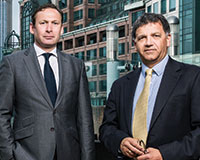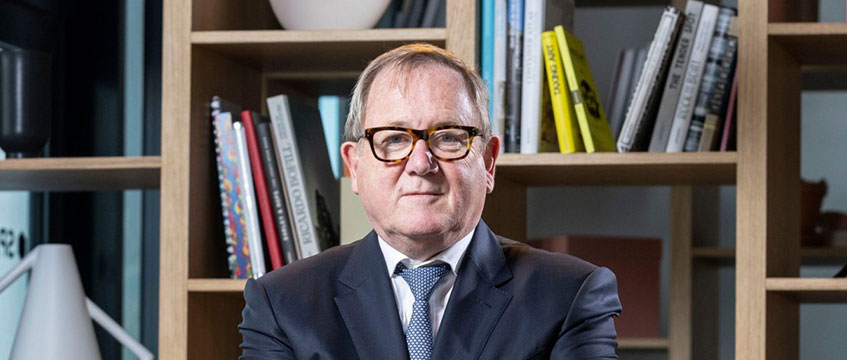Ray Carneiro, Royal Bank of Scotland’s portfolio strategy boss, tells Katie Puckett why streamlining, new working patterns and more organic occupation of offices are vital for future success.
Flexibility has always been important to Ray Carneiro – but his last five years as director of Royal Bank of Scotland’s property portfolio strategy have provided abundant vindication.
Since 2008, the bailed-out bank has shed nearly 41,000 jobs and large chunks of its operations around the world, and Carneiro has been responsible for aligning its global footprint to the much changed market conditions it now finds itself in.
“Suffice to say, it has been a busy time from a property point of view,” he says, with characteristic understatement. “For me, property is all about trying to build in flexibility and enable businesses to change direction if they need to. As we know, economic circumstances can change and we need to be agile enough to react to that.”
As his colleagues in RBS’s property investment division sell off its assets to knock its balance sheet into shape for privatisation, Carneiro is streamlining its own corporate offices to serve the needs of the various divisions as efficiently as possible through rationalisation, consolidation and moving staff to lower-cost locations.
RBS’s footprint covers 33m sq ft – about 10m sq ft less than five years ago – across 4,500 offices and retail premises throughout the world. Around half of that is offices, and of 600 global locations, around half are in the UK. In London, RBS occupies 2m sq ft, with front- and middle-office functions largely based in four buildings around Bishopsgate, EC2, Coutts’ main office on the Strand, WC2, and support functions in Aldgate, EC3, Bankside, EC2, and Islington, N1. Its London space has reduced by more than 600,000 sq ft over the past four years through the closure of peripheral buildings or smaller locations and by exiting 199 Bishopsgate , where it occupied more than 100,000 sq ft.
Under its Advantage ?London programme, it is also consolidating the London offices of its wealth division from seven into two, and exiting Coutts’ office on Fleet Street, EC4 as well as Cadogan Place, SW1, St Mary Axe, EC3, Canary Wharf, E14, and Cavendish Square, W1, while reinvesting in its main location at 440 Strand and co-locating staff in Premier Place on Devonshire Square, W1.
“We have concentrated on fewer and larger properties, where we can leverage our infrastructure, get better economies of scale and efficiencies and bring forward new workplace configurations and agility,” says Carneiro. “We will consistently realign that requirement as the businesses decide how many people they need in central London to support the group’s customers.”
Strategic plans
Carneiro bases decisions about how much space is required and where on the strategic plans produced annually by each division – he then works out how to reconcile that with RBS’s legacy portfolio. “It is driven primarily by the businesses rather than by property. As fast as they recalibrate their strategic direction, we are working hand-in-hand to develop a property plan to support that.”
As for further disposals, he says it is too early to make announcements while the government timetable on privatisation is unknown. “Property solutions will be part of the response to the business direction, but we are very much in the hands of the government at the moment. Our strategic plans are already in place and announced to the marketplace, and I wouldn’t anticipate any significant change in direction.”
One way that RBS has been increasing its efficiency is through a flexible working programme called Choice, launched in 2012 and headed by Tim Yendell. RBS Choice has been instrumental in supporting the consolidation of the portfolio, says Yendell, but is also intended to improve employees’ work-life balance and their productivity, allowing them to work any way, anytime, anywhere. “Over the years, there has been a change from a very rigid format in terms of the way we create and occupy offices into a more organic one. The notion of everybody coming to sit at a desk is just not the way that we see work unfolding at RBS. If work can be done anywhere, the role of the office is to bind people together and create a destination that they will come into to collaborate with colleagues.”
Sofa meetings
In the RBS office of five years’ time, he foresees a huge reduction in the number of traditional desks. “It would be very much akin to an airport lounge, very social, less corporate and more human. So you would see people going from a lounge area to sit at a high desk of some description, then to a meeting room with a sofa rather than a meeting table and chairs. You would see more interactions going on and fewer people sitting at a desk typing away at computers because they would be connected into the WiFi using smart devices.”
Quite a distance from the corporate office of today. “That is the vision rather than the stated path,” cuts in Carneiro quickly.
As for what that means for RBS buildings, the key characteristic is again flexibility. Carneiro wants modern buildings with large floorplates, good floor-to-ceiling heights and the infrastructure to support high-density occupation – the average across RBS’ portfolio is less than 10m2 per person, though that drops to less than 9m2 in some places – and all the technology that totally flexible working requires.
Buildings that can’t offer that will be clear candidates for disposals, though lease events will play a big part in the decision. “Sometimes we will come out of a different building to where a division is departing because we have the chance to do so. Where you are weighing up the certainty of the lease expiry or break versus the vagaries of being able to sublet in the market over the last few years, we have tended to go for what we know we can achieve.”
What he doesn’t want are long leases without break clauses. “As we can see from the sins of the past, being locked into locations with no flexibility is not good when the property market is weak. Some of our longer-term leases are tough for us now because we haven’t been able to look at subletting, so we have to make the best of what we’ve got. If I look abroad there is far greater flexibility for the occupier in Asia, or in France, where we have 3-6-9 leases. My ideal would be an annual break clause on a rolling basis – but I recognise that that’s not on offer.”
He would be happy to take a 100-year lease, if it had an annual rolling break: “The bottom line is we love flexibility, which is the opposite to what the landlord or investor wants. Sometimes it is appropriate to take a longer lease, but my preference would still be to get the break.”
Ray Carneiro
Job Director of property portfolio strategy
Age 57
Home Pinner, Middlesex
Family Married with three grown-up children
Career Early career spent at Citigroup/Citibank International, where he became director of real estate. In 2000, he joined Prudential as head of corporate property. Headhunted by ABN AMRO ?in 2001, to become global head of real estate and facilities management. Joined RBS in 2009, following its acquisition of ABN AMRO.
Tim Yendell
Job Head of RBS Choice
Age 44
Home Bromley, Kent
Family Married with two sons and a daughter aged 10, 8 and 6.
Career Spent his early career in Asia-Pacific working for a number of interior design firms specialising in corporate real estate, then moved to Australia. Returned to the UK in 1998 as head of capital projects for Energis. Joined RBS in 2005 to develop new occupation strategies, before starting to develop RBS Choice in 2011.











